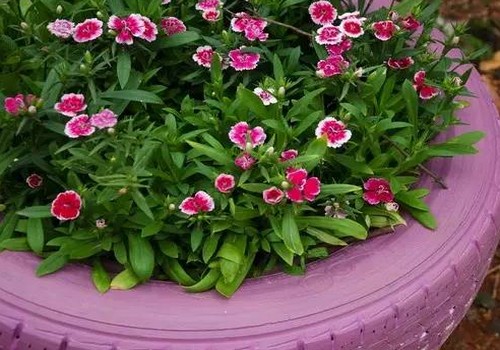Culture method of Golden Dragon with five claws
The five-clawed golden dragon is a common trailing flower in summer and autumn. it is a good material for vertical greening and small flower rack, and can be used as a climbing rattan material at the edge of the hedge. The five-clawed golden dragon is a perennial herb with twining stems, grayish green and often small verrucous protuberances. Leaves alternate, digitally 5-parted, lobes elliptic-lanceolate, entire. Single flower in leaf axil, or 2-3 clusters, Corolla funnel-shaped, light purplish red. Like sunny, warm and humid climate, loose and fertile soil. The following is an introduction to the breeding methods of the five-clawed golden dragon:
[lighting management]
Like the semi-shade environment, in autumn, winter, spring can give enough sunshine, but in summer to shade more than 50%. Put in indoor maintenance, as far as possible in places with bright light, such as well-lit living room, bedroom, study and other places. After indoor maintenance for a period of time (about a month), it should be moved to an outdoor place with shade (heat preservation in winter) for a period of time (about a month), so alternately.
[temperature Management]
Because it is native to the tropics and likes the environment of high temperature and humidity, it is very strict in winter. When the ambient temperature is below 10 ℃, it can not survive the winter safely when the ambient temperature is below 10 ℃.
In the summer:
1. Strengthen the air convection so that the temperature in the body can be released.
2. Put it in the semi-shade, or give it 50% shade
3. Spray it properly, 2 or 3 times a day.
In winter:
1. Move to a brightly lit place for maintenance
2. Outside, you can wrap it with a film to survive the winter, but uncover the film every two days when the temperature is high at noon to let it breathe.
[humidity Management]
Like the humid climate environment, the relative temperature of the air in the growing environment is 70% to 80%, the air relative humidity is too low, the lower leaves are yellowing and falling off, and the upper leaves are not glossy.
[fertilizer and water management]
For potted plants, in addition to adding organic fertilizer when potting, proper fertilizer and water management should be carried out in the usual maintenance process.
Spring, summer and autumn:
These three seasons are its peak growing season. Fertilizer and water management circulates according to the order of "Huabao"-- clear water-- "Huabao"-- clear water. The interval period is about 1-4 days, and the interval period is shorter during sunny or high temperature days. The interval period is longer or not irrigated during rainy days or low temperatures.
Winter:
During the dormant period in winter, the main task is to control fertilizer and water. Fertilizer and water management circulates according to the order of "Huabao"-clear water-clear water-"Huabao"-clear water-clear water, the interval period is about 3-7 days, the interval period is shorter during sunny or high temperature, and the interval is longer or not watered during cloudy and rainy days or low temperature.
For ground-planted plants, fertilizer and water were applied 2 to 4 times in spring and summer according to drought conditions: first, a small trench was opened at 30cm to 100cm outside the root neck (the larger the plant, the farther away from the root neck), the width and depth of the ditch were both 20cm. The ditch is sprinkled with 25-50 jin of organic fertilizer, or 1-5 two-grain compound fertilizer (chemical fertilizer), and then poured with water. After the beginning of winter, before the beginning of spring, fertilize again according to the above method, but do not need watering.
Time: 2019-06-01 Click:
- Prev

Flowering time and Culture method of Cymbidium
Smiling gentleman orchid is a kind of gentleman orchid, when the flower blossoms, each floret sagging in the shape of a bell, seems to bow his head and smile to people, hence the name of laughing gentleman orchid. Smiling gentleman orchid elegant and solemn, narrow leaves, orange flowers, open drooping, bucket-shaped, is the layout of the venue during the Spring Festival
- Next

Culture methods and matters needing attention of Carnation Flower
Carnation, also known as Luoyang flower, Chinese marsh bamboo, carnation flower, carnation orchid, ten kinds of landscape flower, Wang Yinghua, Luoyang carnation, chrysanthemum, embroidered bamboo, Changxia, sunset grass, qu wheatgrass, etc., is a perennial herb of the carnation genus of Caryophyllaceae, and is one of the traditional famous flowers in China.
Related
- Fuxing push coffee new agricultural production and marketing class: lack of small-scale processing plants
- Jujube rice field leisure farm deep ploughing Yilan for five years to create a space for organic food and play
- Nongyu Farm-A trial of organic papaya for brave women with advanced technology
- Four points for attention in the prevention and control of diseases and insect pests of edible fungi
- How to add nutrient solution to Edible Fungi
- Is there any good way to control edible fungus mites?
- Open Inoculation Technology of Edible Fungi
- Is there any clever way to use fertilizer for edible fungus in winter?
- What agents are used to kill the pathogens of edible fungi in the mushroom shed?
- Rapid drying of Edible Fungi

